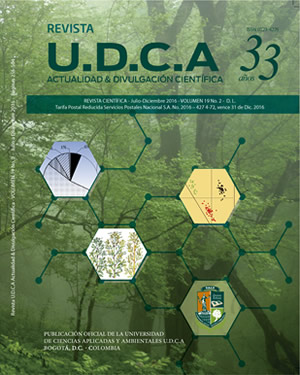Evaluación del efecto auxin-like de ácidos húmicos en maíz mediante análisis digital de imágenes
Evaluation of auxin-like effect of humic acids on maize through digital image analysis
Contenido principal del artículo
Resumen
Palabras clave:
Descargas
Datos de publicación
Perfil evaluadores/as N/D
Declaraciones de autoría
- Sociedad académica
- Universidad de Ciencias Aplicadas UDCA
- Editorial
- Universidad de Ciencias Aplicadas y Ambientales U.D.C.A
Detalles del artículo
Referencias (VER)
ABRAMOFF, M.D.; MAGALHÃES, P.P.; RAM, S.J. 2004. Image processing with ImageJ. Biophotonics International. (United States). 11(7):36-43.
ARNOLD, A.E. 2007. Understanding the diversity of foliar endophytic fungi: progress, challenges, and frontiers. Fungal Biology Reviews. (United Kingdom).21(2):51-66.
BARROS, L.; CANELLAS, L.; LOPES, F.; OLIVEIRA, N. 2010. Bioactivity of chemically transformed humic matter from vermicompost on plant root growth. J. Agric. Food Chem. (United States). 58(6):3681-3688.
BOHÓRQUEZ, C.; ÁLVAREZ-HERRERA, J.G.; NIÑO, R.C. 2011. Giberelinas y 6-Bencialminopurina en la plantulación de semillas de tomate (Solanum lycopersicum L.) Híbrido Adrale RZ F1. Temas Agrarios. (Colombia). 16(2): 42-53.
CABEZAS-GUTIÉRREZ, M.; PEÑA, F.; DUARTE, H.W.; COLORADO, J.F.; SILVA, R. 2009. Un modelo para la estimación del área foliar en tres especies forestales de forma no destructiva. Rev. U.D.C.A Act. & Div. Cient. (Colombia). 12(1):121-130.
CANELLAS, L.P.; OLIVARES, F.L.; OKOROKOVA- FAÇANHA, A.L.; FAÇANHA, A.R. 2002. Humic acids isolated from earthworm compost enhance root elongation, lateral root emergence, and plasma membrane H+-ATPase activity in maize roots. Plant Physiology. (United States). 130(4):1951-1957.
CANELLAS, L.P.; PICCOLO, A.; DOBBSS, L.B.; SPACCINI, R.; OLIVARES F.L.; ZANDONADI, D.B.; FAÇANHA, A.R. 2010. Chemical composition and bioactivity properties of size-fractions separated from a vermicompost humic acid. Chemosphere. (United Kingdom). 78(4):457-466.
CANELLAS, L.P.; OLIVARES, F.L. 2014. Physiological responses to humic substances as plant growth promoter. Chem. Biol. Techno. Agricult. (Itlay). 1(1):1-11.
CANELLAS, L.P.; OLIVARES, F.L.; AGUIAR, N.O.; JONES, D.L.; NEBBIOSO, A.; MAZZEI, P.; PICCOLO, A. 2015. Humic and fulvic acids as biostimulants in horticulture. Scientia Horticulturae. 196:15-27.
CUBILLOS, J.G.; MILIAN, P.E.; HERNÁNDEZ, J.L. 2011. Biological nitrogen fixation by Rhizobium sp. native gliricidia (Gliricidia sepium [ Jacq.] Kunth ex Walp.) under greenhouse conditions. Agr. Col. 29(3):465-472.
GALINDO, J.; CLAVIJO, J. 2007. Modelos alométricos para estimar el área de los foliolos de arveja (Pisum sativum L.). Ciencia y Tecnología Agropec. (Colombia). 8(1):37-43.
GHOLAMI, A.; SHAHSAVANI, S.; NEZARAT, S. 2009. The effect of plant growth promoting rhizobacteria(PGPR) on germination, seedling growth and yield of maize. Int. J. Biol. Life Sci. (Australia). 1(1):35-40.
HERRE, E.A.; MEJÍA, L.C.; KYLLO, D.A.; ROJAS, E.; MAYNARD, Z.; BUTLER. A.; VAN BAEL, S.A. 2007. Ecological implications of anti-pathogen effects of tropical fungal endophytes and mycorrhizae. Ecology. (United States). 88(3):550-558.
LOBET, G.; PAGÈS, L.; DRAYE. X.A. 2011. Novel imageanalysis toolbox enabling quantitative analysis of root system architecture. J. Plant Physiology. 157(1):29-39.
NARDI, S.; PIZZEGHELLO, D.; SCHIAVON, M.; ERTANI, A. 2016. Plant biostimulants: physiological responses induced by protein hydrolyzed-based products and humic substances in plant metabolism. Scientia Agricola. 73(1):18-23.
PEÑA, E.M.; HAVEL, J.; PATOCKA, J. 2005. Humic substances-compounds of still unknown structure: applications in agriculture, industry, environment, and biomedicine. J. Appl. Biomed. (Czech Republic).3(1):13-24.
PORRAS, A.; SORIANO, M. L.; PORRAS, A.; AZCÓN, R. 2009. Arbuscular mycorrhizal fungi increased growth, nutrient uptake and tolerance to salinity in olive trees under nursery conditions. J. Plant Physiology. (Germany). 166(13):1350-1359.
RAMOS, A.C.; DOBBSS, L.B.; SANTOS, L.A.; FERNANDES, M.S.; OLIVARES, F.L.; AGUIAR, N.O.; CANELLAS, L.P. 2015. Humic matter elicits proton and calcium fluxes and signaling dependent on Ca2+-dependent protein kinase (CDPK) at early stages of lateral plant root development. Chem. Biological Technol. Agriculture. 2:3.
RINCÓN, N.; QUINTERO, A.; PÉREZ, J. 2012. Determinación del área foliar en fotografías tomadas con una cámara web, un teléfono celular o una cámara semiprofesional. Rev. Fac. Nal. Agr. (Colombia).65(1):6399-6405.
SANI, B. 2014. Foliar application of humic acid on plant height in canola. APCBEE Procedia. (China). 8:82-86.
SCHNEIDER, C.A.; RASBAND, W.S.; ELICEIRI, K.W. 2012. NIH Image to ImageJ: 25 years of image analysis. Nat Methods. (United Kingdom). 9(7):671-675.
SHARIF, M.; KHATTAK, R.A.; SARIR, M.S. 2002. Effect of different levels of lignitic coal derived humic acid on growth of maize plant. Communications Soil Sci. Plant Analysis. (United States). 33(19-20):3567-3580.
VALERO, N.; GÓMEZ, L.; PANTOJA, M.; RAMIREZ, R. 2014. Production of humic substances through coal-solubilizing bacteria. Brazilian J. Microbiol. 45(3):911-918.
VAN DER WEELE, C.M.; JIANG, H.S.; PALANIAPPAN, K.K.; IVANOV V.B.; PALANIAPPAN, K.; BASKIN, T.I. 2003. A new algorithm for computational image analysis of deformable motion at high spatial and temporal resolution applied to root growth. Roughly uniform elongation in the meristem and also, after an abrupt acceleration, in the elongation zone. Plant Physiol. 132(3):1138-1148.
WANG, X.; PAN, Q.; CHEN, F.; YAN, X.; LIAO, H. 2011. Effects of co-inoculation with arbuscular mycorrhizal fungi and rhizobia on soybean growth as related to root architecture and availability of N and P. Mycorrhiza. (Germany). 21(3):173-181.







